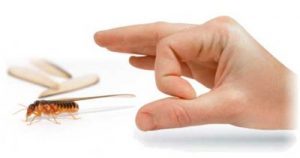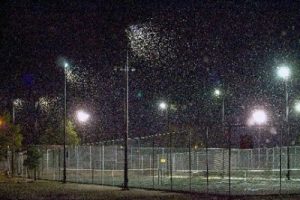
Just to be clear, you shouldn’t think that there’re some termite subspecies which have wings and can fly while others can’t.
It’s not true. In fact, flying termites are just members of one of three castes in termites’ “society”.
The other two are soldiers and workers. However, flying termites don’t live their whole lives as flying ones.
After they fly out of a colony, they shed their winds, mate and start a new one, having become kings and queens.
Hide content
- Appearance
- Signs
- Inspection
- Killing
- Whole-structure treatment
- Spot treatment
- Prevention
- Useful articles
- Helpful video
- Conclusion
So, as you can figure out that this is their primary purpose: colonize new lands and reproduce since they are the only ones who can fly and mate. This is the reason why flying termites are also called “swarmers” or “alates”.Appearance
If you spotted a flying termite, first of all you should make sure it’s a termite, not ant. Unlike ants, a flying termite has:
- Straight antennae.
- A broad waist.
- All wings of the same size.
Besides, you should understand which kind of alates is in your house: Drywood or Subterranean.
Because Drywood ones shed wings just after they mate and subterranean ones can carry them until they die.
There would be many winged individuals among the dead Subterraneans and none among dead Drywoods.
Learn more about drywood termites: signs of their activity; best methods of treatment: spot treatment and DIY methods; how to get rid of them in furniture?
Signs
The first second you need to do is to check if the infestation of your house is already a matter of fact or it’s just one species that has happened to fly into an opened window.Those are the warning bells:
- Wings shed around the house, especially onto window sills.
- Decayed wood. Termite damage generally follows the grain of the wood. Termites also line the damaged wood with soil.
- Shelter tubes, dug up in concrete blocks and bricks.
- Feces, resembling pellets.
When Drywood termites can only fly into your house or be brought along with an infected wooden item, Subterranean can also come through cracks in basement.
Furthermore, Subterranean ones don’t usually nest within a building, they just come there for food; their nests are normally located, as the name implies, underground.
Anyway, you should check your basement for brown, dry cylindrical tunnels if you notice a swarmer. The tunnels made by subterranean termites contain broken mud particles with fecal materials.
One more way to determine which type of termites has attacked your property is to find out which kinds live in your region and use elimination approach. E.g. only subterranean termites can be found in the state of Minnesota.
Learn more about subterranean termites: signs of their activity; best methods of treatment and DIY methods. Eastern subterranean termites and their tunnels and tubes with photo.
Inspection
What else you should do is to check wooden items and parts of the building to find the colony (-ies).
It isn’t worth mentioning that termite infestation is invisible at first, so the abovementioned visual inspection will be not enough.
Hit the wood with hammer; if it sounds dull, there may be termites inside.
To make sure, you can take a probe with an ice pick or a screwdriver in the place where they may be to find out exactly.
Killing
There is no sense in hunting down flying termites only, since alates themselves are not a threat. Extermination should be made along with the colonies only; otherwise all efforts will be in vain.Nobody will give you definite answer on the questions: “How to get rid of flying termites in house?”, “How to get rid of winged termites?”, “How to kill flying (winged) termites?”, “How to kill termites with wings?” etc., since there’re many different techniques of getting rid of flying termites. But you should know that some of remedies are only applicable for killing one specific kind of termites and that’s why it’s important to determine which ones are in your house.
The techniques of termite treatment are divided into two groups: whole-structure treatment and spot treatment. Names speak for themselves: whole-structure treatment exterminates all termites in a building, no matter where exactly their colonies are.
As you can guess, this method is used in cases of extremely massive termite invasion. On the contrary, spot treatment deals with isolated areas of the house and applied in minor cases. So when using the latter one, you should know precisely where your termites have settled down.
Whole-structure treatment
One way of killing all termites in your house is fumigation with sulfuryl fluoride and methyl bromide. Those matters kill termite within several days in all corners of a structure, leaving them practically no hope for survival.
Unfortunately, this method can hardly be applied by amateurs, because of need in wrapping the entire house in tarpaulins, difficulties in determining the right dosage and the necessity to buy expensive gear like protective suits and gas masks.
People not wearing gas masks should stay out of that house for two days, all pets should be taken away from the house, and all food must be carried away as well or kept in hermetic packages because the chemical is poisoned.
One more way to eradicate the vermin in the whole building is to heat it up.
When termites are exposed to temperature at least 120 °F during 33 minutes, they all inevitably die.
Although this method usually takes less time than fumigation and uses no venomous pesticides, it is still hard to apply by non-professional, because it requires purchasing expensive, complex equipment and attended with risks of damaging some parts of the home. Moreover, some hard-to-heat places may remain untreated.
Notice that whole-structure treatment doesn’t affect nests in the depth of the ground outside the house, so its efficiency in relation to subterranean termites is limited.Here you can learn more information about effective treatment method called tenting (fumigation): dangers for termites, preparing for fumigation and cleaning after, how long does this procedure last?
Spot treatment
How to get rid of flying termites by yourself? Here are some treatments that could help you to kill flying termites:
- Cardboard traps. Set it, dampen it, burn it after they gather on the top. Good for killing subterranean termites. It’s better to set them outdoors.
- Soil poisoning. Just water all soil along the perimeter of your house with pesticides to not let subterranean termites in. Inject it everywhere along the foundation, beneath concrete slabs, and within foundation walls. For example, you can use poison containing borax powder or sodium borate.
- Colony poisoning. Drywood termites will die if you take venomous foam, liquid or dust and then pump some into their homes. These are the substances you can use for this purpose: liquid organophosphates, liquid pyrethroids, borate dust, silica gel dust, liquid nitrogen, natural oils.
Unfortunately, you’ll have to drill some holes in wood to get to their galleries, but the game worth candles.- Microwave treatment. This treatment for termites with wings is quite effective one, which unfortunately requires buying expensive equipment. Besides, it may harm your house if misused. Better leave this technique for professional.
- Electrocution. The same as the previous one.
- Biological control. Send some life forms detrimental for termites e.g. nematodes. Alas, this method hasn’t yet proved to be effective.
- Wood replacement. Simply take the colony and carry it away along with the thing it exists in.
Prevention
If you spotted a swarmer but didn’t spot a colony, you may want to avoid the colony to appear in future.
In this case you should:
- treat soil around;
- cover wooden items with curer;
- make sure there’s no water accumulating near the foundation;
- ventilate hidden spaces;
- remove all mulch and waste lumber you can;
- take off dense vegetation, leaning onto the building;
- close cracks in foundation.
Useful articles
If you interested in more information of termites we recommend you to read the following articles:
- All types of termites. Are they harmful to humans? Can they bite you? And what is the difference between drywood and subterranean ones?
- What does swarmers of different species look like: drywood, subterranean, formosan?
- Signs of infestation outside and in the house: in walls or furniture.
- What does termite holes look like? What is droppings and is it toxic to humans? Do termites make noises?
- Posible termite damage, how does it look like? Examples of damage in walls and wood floors.
- All about flying termites: how do they look like, swarming season.
- How do they do nests and mounds? How to find it in your garden or inside the house?
- Termite life cycle – from egg to larvae. And social hierarchy: workers, soldiers, queen.
Helpful video
In order to kill winged termites, all that is needed is a vacuum cleaner or liquid spray. More info in the video:
Conclusion
The algorithm is simple:
- If you see a flying insect, see whether it’s a termite swarmer or not.
- If you are sure it’s a swarmer, try to find colonies.
- If you are sure that there’re no colonies within the house and/or in soil around, take measures to prevent future infestation.
- If you’ve found a colony or colonies, treat them.
- If you are unable to find all colonies and/or to treat them successfully, then you should resort to a professional who can, e.g. by treating the whole building.


